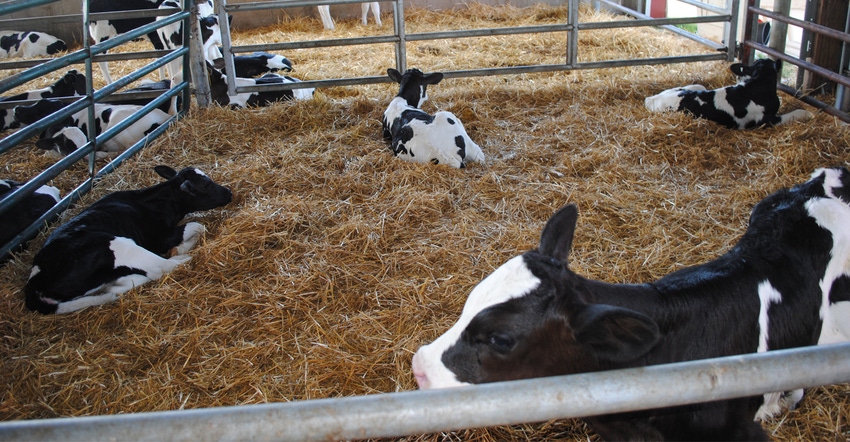January 25, 2017

The cost to raise replacement heifers is commonly the second-highest expense on dairy farms, topped only by lactating-herd feed costs. Replacement heifer rearing can be a challenging economic situation with real current costs but no current revenue. Yet performing a quality job with replacement heifers is an investment with real future returns. Analyzing and managing heifer costs without compromising performance may mean the difference between profit or loss in tight margin years.
In 2017, University of Wisconsin Extension ag agents plan to collect farm-level data to update Extension’s report on the cost of raising dairy heifers. This year we are looking to increase the number of automated calf feeder operations and grazing operations in the study. Historically, these have been referred to as the Intuitive Cost of Production Analysis (ICPA) reports. Past and present reports can be found online at eauclaire.uwex.edu/uwex-icpa-project. Please contact your local UW Extension ag agent if you would like to learn more or participate.
In 2015, updated feed and calf values were added to previously collected farm performance data from 2013. That update illustrated year-to-year variability in costs, with a 15% decrease in feed costs over those two years, and a $250 increase in calf value over the same two-year period.
• Calf enterprise. For the calf enterprise, defined as from birth to being moved to group housing, the average cost per calf per day was $5.51 in 2015. Costs are broken down into four categories: feed, labor and management, fixed costs, and other variable costs. For calves, feed represented 43% of the total daily cost, with labor and management at 15%, fixed costs at 6% and other costs at 36%.
Using the same four cost categories for heifers (from group housing up to calving), the average daily cost was $2.77, with 54% going to feed, 16% to labor and management, 12% to fixed costs and 18% to other costs. Just as with the lactating herd, feed costs are most often the No. 1 expense category for heifers.
While the data from the ICPA studies provide excellent benchmarks, we encourage producers to determine their own costs. There is variability among farms in both fixed and variable costs observed in these studies, showing once again that average numbers don’t always tell the whole story. From our experience, here are a few suggestions for assessing costs on your own farm:
• Labor. When it comes to labor costs, we often think just of daily feeding and bedding chores. To fully account for labor, also determine the hours of labor needed for tasks that are done weekly, monthly and even yearly. These more intermittent tasks can be things such as hauling manure, vaccinating, treating sick calves, etc. Labor needs should be determined for both paid and unpaid labor. Farmers like to tell us they work for free, but in reality, there is an opportunity cost for unpaid labor that could be used elsewhere.
• Machinery and equipment. These costs are also referred to as fixed costs or depreciation costs. This is a common area to struggle with to determine costs. Equipment costs should be prorated for uses specific to heifer needs. For example, the skid steer may see multiple uses in a day. Make your best estimate for what percentage of the time it’s used for heifers, and allocate that percentage of its depreciation cost to the heifer enterprise. Information needed for determining depreciation costs are current market value, years of useful life left, and trade in or salvage value. It’s easy to forget to include smaller-ticket items such as calf pails, bottles, etc.
• Feed. You need to figure a fair market value for homegrown feeds as well as tally purchased feed costs. You then need to determine amounts fed, which isn’t always known on a day-to-day basis. For example, you may need to compute that a large bale of hay lasts for X number of days, and there are X number of heifers in that pen. With an accurate estimate of bale weight, you can then backtrack total hay usage as well as pounds per heifer per day. The same approach can be used for purchased feed. For example, you purchased X number of bags of milk replacer last year, and raised X number of calves. You can then use that information to estimate cost per calf.
Finally, don’t forget costs for the vet, medicine, breeding, bedding, trucking, death loss, etc. This is a lot of information to analyze and organize all at once, but it’s doable if completed in steps. Going through this process can help identify areas for improvement and give yourself kudos for areas you are performing well in.
Bear in mind there may be multiple reasons for certain costs to be high or low. This process is to help you narrow the search, but may require further investigative work. For example, high feed costs could be due to high prices paid, but could also be attributed to excessive waste at the feed bunk. Investing time now analyzing your heifer-raising costs can pay dividends down the road.
Sterry is the St. Croix County Extension ag agent. This column is provided by the University of Wisconsin Extension Dairy Team.
About the Author(s)
You May Also Like




